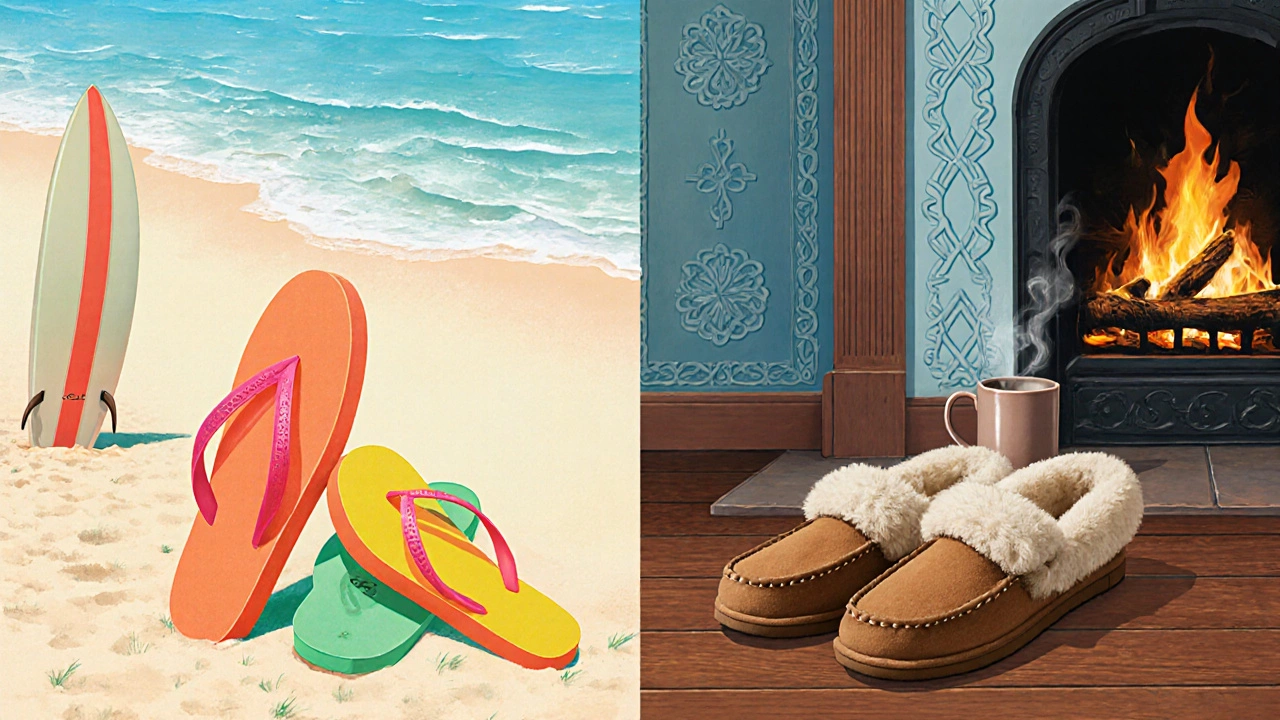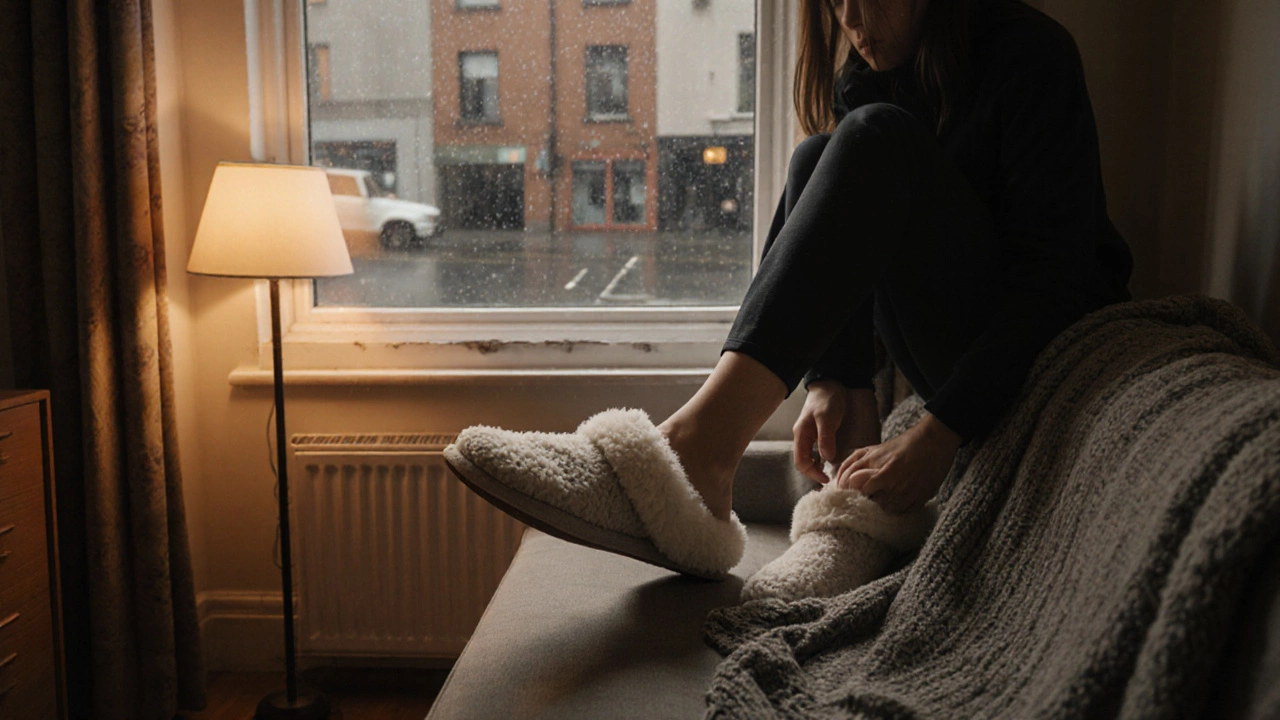US vs Irish Shoe Size Converter
Result will appear here
Remember: US sizes are typically half a size larger than UK/Ireland sizes. Always check size charts when shopping between countries for slippers and house shoes!
When you hear someone in Dublin say they’re slipping on a pair of Slippers, you’re most likely picturing a cozy, indoor shoe. In the Irish market, the same word has a familiar feel, but across the Atlantic the usage can be a little different. Below we break down how American English treats the term, what Irish English prefers, and why the distinction matters if you’re shopping in Dublin, ordering from a US site, or just chatting with a friend from New York.
What “slippers” Mean in American English
In the United States, slippers are usually soft‑footed shoes meant for indoor wear. They’re often made of fleece, shearling, or plush fabric and are marketed as “house shoes.” Major US retailers such as Target, Walmart, and online giant Amazon list them under “slippers” or “house shoes.” A classic American brand is UGG, whose sheepskin models are synonymous with winter comfort. Americans rarely call these shoes “mules” unless they have an open back and no heel strap-those are a specific style rather than a blanket term.
Keywords you’ll see on US sites include “cozy footwear,” “indoor slippers,” and “booties.” The word itself is pronounced the same as in Ireland, but the contexts can shift. For example, a Californian might say, “Grab your slippers before you hit the floor,” while a Midwesterner could add, “Those slippers are perfect for the cold nights.”
How the Irish Say “Slippers”
In Ireland, the term slippers is widely understood, but you’ll also hear “house shoes,” “indoor shoes,” or simply “shoes for the house.” Local brands like Brown Thomas and department store Arnotts carry a range of slippers that match the climate‑friendly vibe of a rainy Irish autumn.
In the Gaeltacht areas, you might encounter the Irish language term “bróga baile,” literally “house shoes,” used on signage in boutique shops in Galway or Dingle. The word “mules” is also used, but it refers to a slip‑on shoe with a closed toe and no back, often worn outdoors, especially in Dublin’s fashion‑forward districts like South William Street.
Regional Variations Across the US and Ireland
Both sides of the Atlantic have regional quirks:
- Southern US: “Slippers” can double as “flip‑flops” during hot summer months, especially in beach towns like Miami.
- New England: You’ll find “slippers” made of wool or sheepskin, similar to Ireland’s preference for warm materials during November storms.
- West Coast US: “Slide sandals” are commonly called “slides” rather than slippers.
- Irish countryside: In County Kerry, “slippers” are often paired with woollen socks to combat damp mornings.
- Urban Dublin: Trendy “mules” and “fancy slippers” appear in boutique stores on Grafton Street, blurring the line between indoor and outdoor footwear.
Understanding these nuances helps when you’re ordering online. Pick the right size, material, and style based on whether the product description leans toward American “slippers” (more indoor‑centric) or Irish “house shoes” (often designed for a wetter climate).

Buying Slippers in Ireland vs the US
If you’re scrolling through an Irish e‑commerce site, look for filters like “indoor,” “water‑resistant,” or “wool.” Stores such as Brown Thomas and the Irish branch of Smyths often label products with “Irish‑made” or “crafted in Cork.” Shipping from the US can add extra cost, especially for bulky sheepskin models, and customs may apply a duty on “footwear > £100.”
For budget‑friendly options, the Irish discount chain Dunnes Stores stocks basic cotton slippers at under €15, while an American online deal might drop a pair of UGG slippers to $45 during a Black Friday sale. Remember that US sizes run a half‑size larger than UK/Ireland sizes, so convert carefully.
Common Confusions and Tips for Tourists
- Don’t assume “slippers” means “flip‑flops” in Ireland; most locals will expect a closed‑toe, soft‑sole shoe.
- If a US website lists “slippers” but shows a sandal‑like image, it’s likely referring to “slides.” Check the material description.
- When asked “Do you have slippers?” in a Dublin hotel, expect a pair of cotton or fleece indoor shoes, not beach‑type sandals.
- Irish pubs often provide a pair of disposable “house shoes” to keep floors clean-these are a different category from the plush slippers you might buy for home use.
- In Belfast, you’ll hear “house shoes” used interchangeably with “slippers” in retail signage, so keep an eye on both terms when hunting for a deal.
These pointers will keep you comfortable whether you’re lounging by the fireplace in a Kerry cottage or catching a late‑night show at the 3Arena in Dublin.

Quick Reference Table: US vs Irish Terminology
| US Term | Irish Equivalent | Typical Material |
|---|---|---|
| Slippers | House shoes | Fleece, shearling, plush |
| Mules | Mules (same) | Leather, suede |
| Flip‑flops | Flip‑flops / thongs | Rubber, foam |
| Slides | Slides | Synthetic, canvas |
| Booties | Booties | Wool, knitted |
Frequently Asked Questions
Do Americans use the word “slippers” for indoor shoes?
Yes. In American English, “slippers” refers to soft, indoor footwear designed for comfort around the house.
What’s the Irish term for “slippers”?
Most people say “house shoes” or simply “slippers.” In Irish language contexts you might see “bróga baile.”
Are “mules” the same as slippers?
Not exactly. Mules are slip‑on shoes with a closed toe and no back strap, often worn outdoors. They’re a specific style, not a blanket term for indoor footwear.
Where can I buy quality slippers in Dublin?
Check out Brown Thomas on Grafton Street, Arnotts, or the local outlets of Dunnes Stores and Smyths for a range of cotton, fleece, and wool options.
How do US shoe sizes compare to Irish sizes?
US sizes are typically about half a size larger than UK/Ireland sizes. A US men’s 9 usually translates to a UK/Ireland 8.5.
